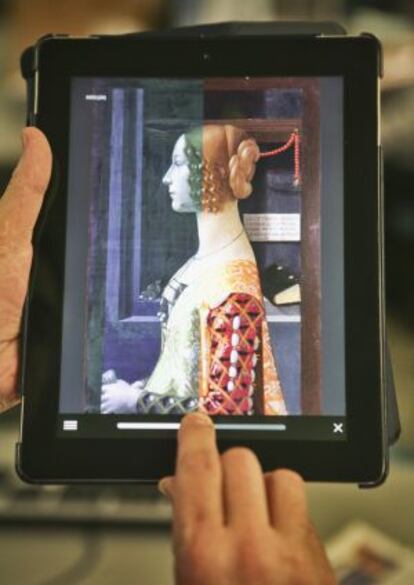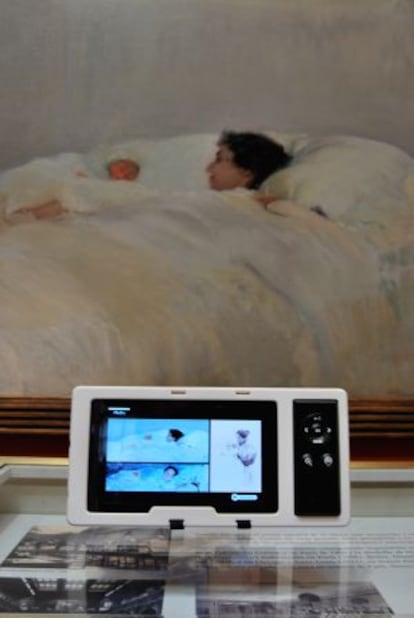To visit, or switch on, the Prado?
A technological revolution that goes beyond cellphone apps is underway in the major museums

The Louvre fits in your pocket. So do the MoMA, Prado, Thyssen and Tate Modern – and all at the same time. Museums from all over the world are jumping on the technology bandwagon with one very clear goal in mind: mobile devices.
“It is inevitable that cultural institutions are making headway in digital media,” asserts Nuria González Ubieta, deputy director of publications at the Guggenheim Bilbao.
Elyse Topalyan, vice-president of communications at the Metropolitan Museum of Art in New York, speaks along the same lines. “Just 12 months ago the global debate moved from apps as a field of experimentation to apps as a strategic, crucial fulcrum to a museum’s mission,” she says.
Applications for cellphones and tablets provide an opportunity to discover the world’s masterpieces anytime, anyplace – sometimes for free, sometimes for a fee. But the near future promises the kind of innovation that will spill beyond the limits of the screen and immerse digital visitors in a first-hand experience. With items such as Oculus Rift – virtual reality glasses due to hit shelves late this year with a price tag of around 220 euros – it will be possible to walk around an art gallery without getting up from your couch or subway seat.
Europeana, the EU’s digital library, which contains over two million works from European libraries, was the first institution to explore such a possibility. The resulting application lets visitors take a digital tour of part of Amsterdam’s Rijksmuseum, which contains masterpieces by the likes of Rembrandt and Vermeer. “We have developed a demo version, not an application for commercial purposes,” explains Wiebe de Jager, marketing manager for Europeana. “It is a demonstration of what it is possible to do with our cultural funds in a virtual setting.”
But before diving into this alternative reality, museum visitors already have a wealth of mobile apps at their disposal. Most of them afford partial visits of specific museums such as the Guggenheim, Prado, Louvre and New York’s Metropolitan Museum. Typically, they offer people an index of works, interactive maps, an agenda, articles and audiovisual galleries ─ what is known in cultural jargon as “GLAM” (Galleries, Libraries, Archives and Museums).

The difference is in the price. The Guggenheim, for instance, has decided to offer its holdings for free so that people can “plan ahead for their visit.” The Prado has opted for a different strategy: its app aims to become the digital version of the official museum guidebook, and as such is available for half the price of the paper version (€9.95). Cristina Alovisetti, managing director of the Prado, says the price is justified by the ambition: “It’s not an application that plays in the same field as other apps with less content and basic information. This is a permanent consulting tool,” she says.
But the latest trend is for apps with more minimalist ambitions that focus on a single show or artist. The Tate favors this model and offers users 18 applications with prices ranging from between two and three euros. In Spain, the Thyssen-Bornemisza museum has followed the same line with an app devoted to one of its greatest treasures: Domenico Ghirlandaio’s Portrait of Giovanna Tornabuoni. The menu offers the usual options – audio galleries, articles, videos and so on – and a few more experimental ones. It is possible, for instance, to view the painting under three different types of radiation – X-ray, infrared and ultraviolet light – which unveil secrets concealed by the painter’s technique. José María Goicoechea, communications director at the Thyssen, feels this will be the predominant trend in the future. “I think the Thyssen, out of all Spanish museums, is more focused on applications that go beyond general information and aim to rethink content, providing new experiences and viewpoints as opposed to offering the museum collection,” he notes.
ARCO, Madrid’s contemporary art fair, has also stepped on the gas this year, developing two very different apps for mobile devices. On one hand there is Arcogames, which uses works on display to offer children fun activities and lets adults not yet used to such technology to take their first steps. The second app, Artsy, is a purely commercial tool that allowed bidders to purchase art through their smartphones and tablets from February 19 through March 10. “The idea was for anyone wishing to buy works to be able to do so without coming here,” explains ARCO director Carlos Urroz.
But mobile devices are not only useful outside the museum. The revolution is also underway inside. QR codes, those pixel mosaics from which smartphones can glean all manner of information, are quickly making audioguides obsolete. “There is no point to them any more,” says Jaime Solano, the head of GVAM, a Spanish app development firm. According to him, there is another added advantage: “If [visitors] only have one hour available, we offer them an itinerary that’s designed to make the most of it.”
The Met Museum’s Elyse Topalyan agrees. “I think the emerging trend for museums is to look beyond the audio guides and focus on the role of visitors’ mobile devices. That’s where I think we will see the greatest innovations in 2014.”
For now, China is proving Topalyan right. The integration of QR codes has been a complete success at the National Museum of China, one of the top 20 in the world in terms of visitor numbers. Just three months after their debut, the codes had already been scanned 430,000 times. The code for one particular Van Gogh painting was scanned over 17,000 times.

From June 18 to 20, Newcastle will become the world forum where all this technological activity is put to the test at Museumnext, a summit focusing on the future of museums.
The museum 4.0, as the museum of the future is generally referred to, faces two major challenges: the financial viability of all the investment in technology, and getting users interested in this revolution. Nuria González of the Guggenheim admits that it will still be a long while before museums make money out of the apps. “It is not easy to predict whether it will ever become a substantial source of revenue,” she says.
But Wiebe de Jager, the manager of Europeana, has a visionary’s kind of optimism: “Maybe one day we will be able to enter Rembrandt’s The Night Watch and look around to see what the world was like centuries ago. The possibilities are endless.”
Tu suscripción se está usando en otro dispositivo
¿Quieres añadir otro usuario a tu suscripción?
Si continúas leyendo en este dispositivo, no se podrá leer en el otro.
FlechaTu suscripción se está usando en otro dispositivo y solo puedes acceder a EL PAÍS desde un dispositivo a la vez.
Si quieres compartir tu cuenta, cambia tu suscripción a la modalidad Premium, así podrás añadir otro usuario. Cada uno accederá con su propia cuenta de email, lo que os permitirá personalizar vuestra experiencia en EL PAÍS.
¿Tienes una suscripción de empresa? Accede aquí para contratar más cuentas.
En el caso de no saber quién está usando tu cuenta, te recomendamos cambiar tu contraseña aquí.
Si decides continuar compartiendo tu cuenta, este mensaje se mostrará en tu dispositivo y en el de la otra persona que está usando tu cuenta de forma indefinida, afectando a tu experiencia de lectura. Puedes consultar aquí los términos y condiciones de la suscripción digital.
Últimas noticias
There is as much life left to discover on planet Earth as that which is already known
Dozens presumed dead, around 100 injured in fire at Swiss Alps bar during New Year’s celebration
Is porn for women different from conventional porn? We spoke to those who make it
Cartagena de Indias is sinking: What can the city do to mitigate it?
Most viewed
- Reinhard Genzel, Nobel laureate in physics: ‘One-minute videos will never give you the truth’
- David King, chemist: ‘There are scientists studying how to cool the planet; nobody should stop these experiments from happening’
- Oona Chaplin: ‘I told James Cameron that I was living in a treehouse and starting a permaculture project with a friend’
- Sinaloa Cartel war is taking its toll on Los Chapitos
- The Interoceanic Train, the Mexican alternative to the Panama Canal








































